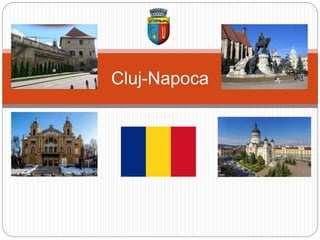Cluj-Napoca
- 1. Cluj-Napoca
- 2. Overview Cluj-Napoca (German: Klausenburg; Hungarian: Kolozsvár; Medieval Latin: Castrum Clus, Claudiopolis; Yiddish: ,קלויזנבורג Kloiznburg), often known simply as Cluj, is the fourth-most populous city in Romania and the seat of Cluj county (Județul Cluj). Located in northwestern Romania in the Someșul Mic River valley, it is approximately midway between Bucharest (324 kilometers, 201 miles), Budapest (351 kilometers, 218 miles), and Belgrade (322 kilometers, 200 miles) and is considered the unofficial capital of Transylvania. It was twice the official capital of the Grand Principality of Transylvania (1790– 1848, 1861–1867). The city lays on the site of Napoca, an ancient Dacian settlement that was made into a municipium by the Romans. Its estimated population at the 2016 census was 321,687. Emil Boc, the Prime Minister of Romania from 2008–2012, is the current Mayor of Cluj-Napoca. Dan Tarcea and Emese Oláh are the two current Deputy Mayors. Gheorghe Șurubaru is the current City Manager.
- 3. Political Map of Romania
- 4. History In the Middle Ages, the name of the city was Culus, as shown in documents dating back to 1173, though it was known as Cluj by the early 15th century (most likely from Castrum Clus, a small fortification dating from 1213). The city has additionally been known by its German name, Klausenburg, and its Hungarian name, Kolozsvár. It became a booming commercial and cultural center; in 1405, it was declared a free town. Under the Constitution of the autonomous Principality of Transylvania (which existed from 1570–1711) in the 16th century, Cluj became its capital. In 1920, the city, with the rest of Transylvania, was ceded to Romania from Hungary. Napoca was added to the city’s name in 1974.
- 5. Hunyad County, an administrative division of the Principality of Transylvania in the early 16th century
- 6. Dismemberment of the Kingdom of Hungary, 1920
- 7. Historic Sites Among the historic monuments are: The house in which Matthias I Corvinus (King of Hungary, 1458–90) was born. The Roman Catholic church of St. Michael (built between 1321–1444), one of the largest Gothic-style churches in Romania; a statue of Matthias I is next to it. The Bánffy Palace (1773–85), now a fine arts museum. The city is the site of the University of Babeș-Bolyai, several technical and professional institutes, the Ion Andreescu Institute of Fine Arts, the Gheorghe Dima Conservatory, and a branch of the Academy of Romania. The Institute of Speleology was the first of its kind in the world. The botanical gardens are considered to be the richest in Romania.
- 8. Birth house of King Matthias I
- 9. St. Michael’s Church (Romanian: Biserica Sfântul Mihail; Hungarian: Szent Mihály- templom)
- 10. Bánffy Palace
- 13. National Romanian Theatre and Opera House
- 14. Industry Industrial progress has been significant throughout the past century. Cluj-Napoca’s products include refrigerating equipment for industrial and domestic use, footwear and leather products, china, cigarettes, and foodstuffs.
- 15. Sources https://www.britannica.com/place/Cluj-Napoca-Romania https://en.wikipedia.org/wiki/Cluj-Napoca https://en.wikipedia.org/wiki/Cluj_County https://en.wikipedia.org/wiki/St._Michael%27s_Church,_Cluj- Napoca















